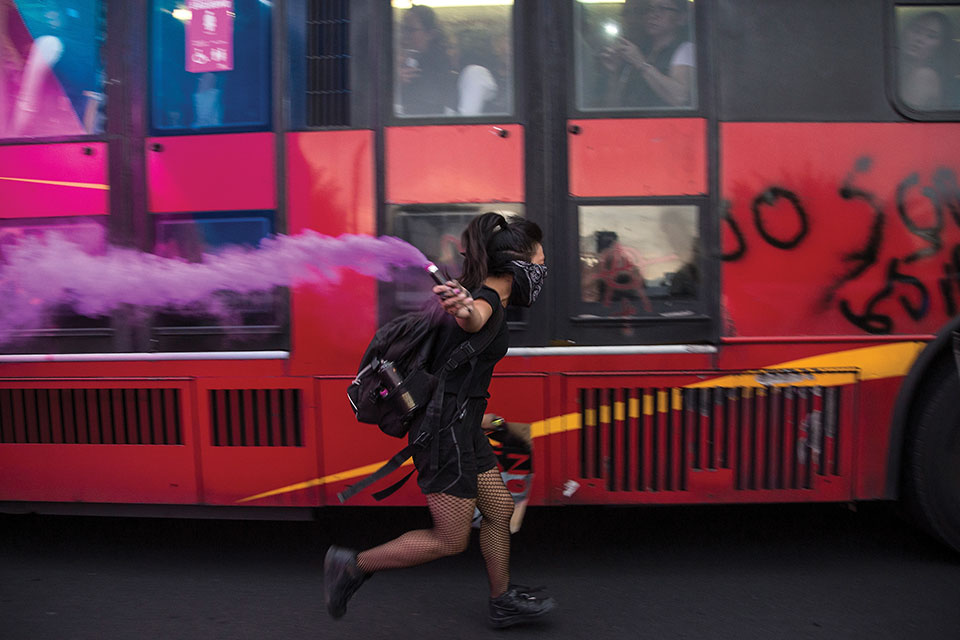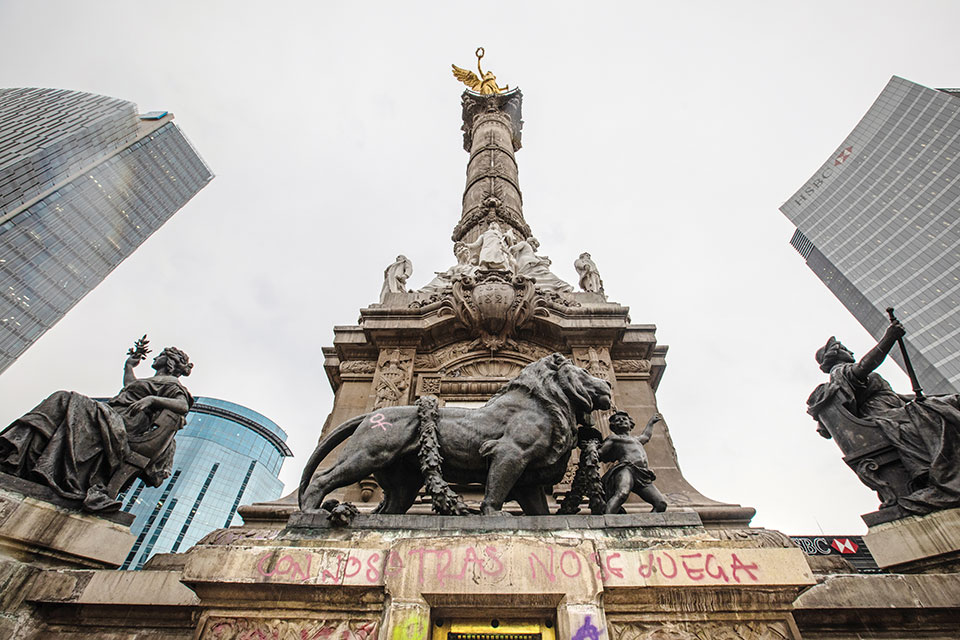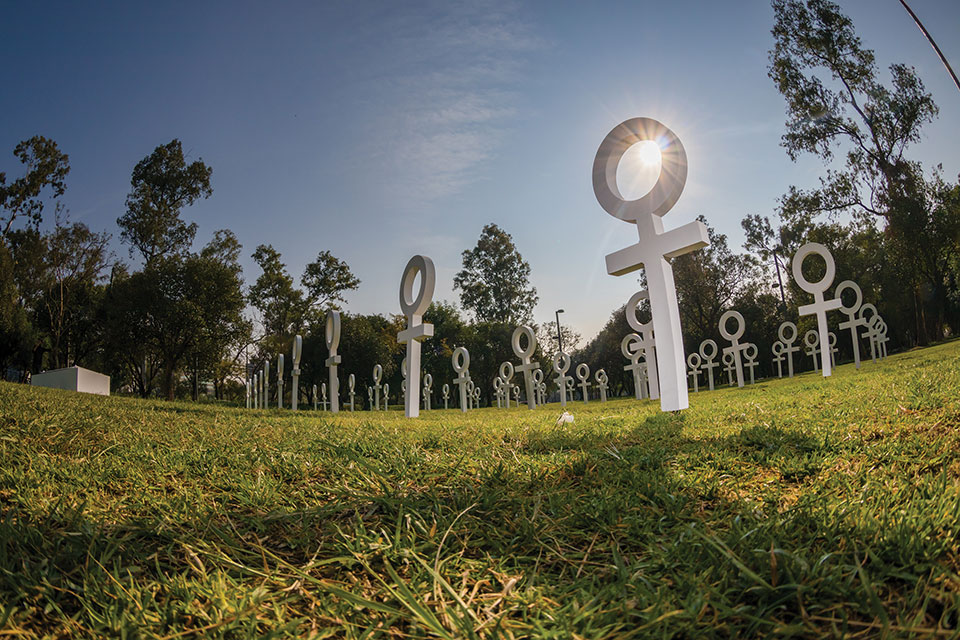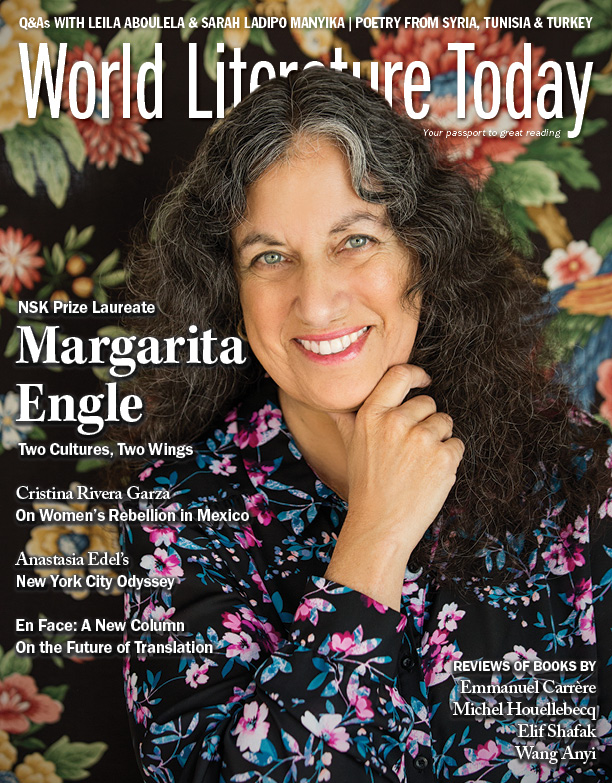On Our Toes: Women against the Femicide Machine in Mexico

Though the feminist response to the war on women had been building in Mexico for years, in 2019 it reached a boiling point. If what was known about gender violence had been a portolans—the medieval map that only outlined the coast—the individual stories of women were now providing the dreadful details of the inland.
Young Mexican women are enraged. And rightfully so. According to recent official statistics, ten women are killed and 4,320 are raped in Mexico on daily basis. They disappear on dusty roads in the hinterland. They text desperate cries for help from taxi cabs run amok. They warn about their executioners in Facebook entries. They stand in long lines to file legal charges against their abusers, to no avail. They go missing in crowded neighborhoods or far-away towns. They are there and, then, they are no longer there. Murderous flickering. Their body parts painstakingly described in news releases: a severed head, two legs, a hand. Meanwhile, they are sorely missed in offices and classrooms, parties, family reunions. Their empty spaces constitute the black hole of a nation gone awry.
The war on women first took the headlines of newspapers in the late twentieth century, when tales of Ciudad Juárez, a notorious border town, got all of us used to the term “femicide.” Unsuspecting audiences thus learned that dark-skinned and long-haired women from the assembly plants were bodies at great risk. From that point on, concomitant to the terror, human rights organizations emerged to demand justice: Norma Andrade and Marisela Ortiz consolidated, forming Nuestras Hijas de Regreso a Casa, a civil organization that sought missing women when authorities desisted or failed to do so. Justicia para Nuestras Hijas was the grass-roots group that embraced Marisela Escobedo, later killed on the streets of Chihuahua while demanding justice for her daughter’s femicide in 2010. The mothers of Ciudad Juárez, much like their predecessors in Argentina or Chile during the military dictatorships, joined forces to urge the state to fulfill its duty: to protect and preserve the safety of its citizens. Rampant impunity, corruption at all levels of government, and a strongly held patriarchal ideology, however, fueled the ceaseless murdering of women from all walks of life.
Despite increasing violence, feminism remained the f-word of Mexican vocabularies.
Despite increasing violence, feminism remained the f-word of Mexican vocabularies. Well into the twenty-first century, most intellectuals—both men and women—generally despised, or unabashedly rejected, feminist ideas, arguing that they were either unnecessary for a world that had achieved acceptable levels of equality or too extreme—a matter better left to crazy women in need of disciplining. Having grown up fearing for their lives, young women from Mexico thought otherwise. And they have acted accordingly. In early August 2019, as authorities failed to apprehend four police officers accused of raping a seventeen-year-old girl, contingents of outraged women, who proudly identified themselves as feminists, descended on the prosecutor’s office clamoring for a meeting with the city’s district attorney. Banners featuring the phrases “They don’t protect me, they rape me” and “If you violate women, we will violate your laws” abounded on-site. Then, as a security officer attempted to assure women the case would be properly investigated, he was doused in pink glitter. Images of the pink head captured national and international attention. A new phase of women’s mobilization against gender violence in contemporary Mexico had begun, but the revolution had been unleashed years earlier.
In July 2015 Mexican poet Maricela Guerrero, also a feminist, along with Paula Abramo and Xitlálitl Rodríguez Mendoza, launched the hashtag #RopaSucia to showcase incidences of misogyny in academic institutions and cultural circles. “Do you remember a misogynous comment from an artist, an editor, a writer, a cultural bureaucrat? Send them to us. Let’s start dancing,” Guerrero tweeted on July 13, 2015. And dancing they did. Going against the well-known Mexican saying “la ropa sucia se lava en casa,” which demands decorum from women, metaphorically asking them to do their dirty laundry within the private limits of home, Guerrero and a surprising number of women opted for airing dirty secrets in public. “Poetry written by women is not as good as poetry written by men in the Spanish-speaking world,” was perhaps the most quoted of phrases. “Your writing is so good it almost looks like man’s writing.” “You might not be a good fit for this grant because you’re pregnant.” Something happens when open secrets—which we all know about and discreetly share—are enunciated in public. They lose their spell, their capacity for stupor or paralysis. RopaSucia speakers not only unveiled the complicity of perpetrators, but in cloaking gender discrimination in concrete words and human stories, they forced others to acknowledge their very existence. Gender violence could no longer be the elephant in the room.
Something happens when open secrets—which we all know about and discreetly share—are enunciated in public. They lose their spell, their capacity for stupor or paralysis.
A year later, under the hashtag #MiPrimerAcoso (my first harassment), women of all ages continued digging into the deepest secrets of patriarchy. Memories of sexual harassment painfully uncovered the makings of a machista system that terrorized girls early in life, forcing them into silence and submission afterward. From molestation to flat-out rape, women’s stories depicted families in turmoil, workspaces riddled with violence, and public spaces in which women more often than not become merely prey. Candid and sordid, these 140-character stories hit a nerve. As with #RopaSucia, the sheer number of participants in #MiPrimerAcoso made clear that the skeletons were ready to walk out of the closet. The unsettling truth that emerged from these tales was that the violence which gave way to femicides was not the exception but the rule in many of these women’s lives. The child molester, the abusive husband, the vicious boss, the rapist, and the murderer were not monsters lurking in the outskirts of cities and villages but “normal” men allowed to threaten and kill women because they could. Impunity cemented the deadly contract that kept women in their places—the kitchen or the coffin. Silence sealed the patriarchal pact that kept men on top.
Impunity cemented the deadly contract that kept women in their places—the kitchen or the coffin. Silence sealed the patriarchal pact that kept men on top.
Once again, in March 2019, Mexican feminist writers and artists joined forces to break the silence surrounding sexual abuse and gender discrimination in workplaces and literary circles. Embracing the methods of #MeToo movements around the world and skillfully using social media, middle-class women of younger generations not only painted frightful scenarios where women were humiliated and torn apart on a regular basis, but for the first time they were willing to name names. On Twitter. And the debate around gender inequality and the femicide machine took on an unexpectedly vociferous and increasingly divisive turn afterward. As feminist organizers called for and disseminated accusations shared anonymously—although, as they explained later, generated in communities of trust—readers, both men and women, reacted with mounting unease and, eventually, wrath.
Most onlookers of violence against women had generally accepted that rapists and killers were deranged men from the working classes or unhinged men from organized-crime ranks, but the names that the Mexican #MeToo aired in public belonged to well-known figures from prominent backgrounds or well-educated men—authors, publishers, curators—the public was not used to fearing. The enemy, it turned out, was at home. A crude argument about the pertinence, and even the legality, of these accusations ensued, with men, and some women, threatening to file charges against #MeToo organizers. Meanwhile, young women from all over Mexico massively sent out stories too painful to bear, overwhelming organizers and taking over the movement.

Revolutions are not orderly affairs, and this wasn’t. No one raised her hand to be allowed to speak.
Revolutions are not orderly affairs, and this wasn’t. No one raised her hand to be allowed to speak. Hastily planned assemblies emerged in Mexico City and elsewhere, where women under duress continued with the outpouring of life stories, providing the language that triggered empathy and bewilderment, identification, and, in some cases, animosity. As women read women’s stories, they saw themselves in situations they had been unable to name. “So it was rape after all,” some of them tweeted, both baffled and liberated by words the patriarchy would rather have hushed. Molestation. Catcalling. Assault. Discrimination. Harassment. Domestic violence. Abuse—physical and financial. Rape. Murder. If what we knew about gender violence had been a portolans—the medieval map that only outlined the coast—each story told by these women was now affording the dreadful details of the inland. The map resulting from the broken silence configured a veritable heart of darkness, and it was not a flattering sight. Some men apologized, making acts of public contrition, including the promise to look for professional help. Others did not even acknowledge accusations against them. Some were fired from their jobs. Some threatened revenge. And, as a sector of public opinion remorsefully attended to the tarnished reputation of men, the suicide of famous Mexican singer Armando Vega Gil, who was accused of child molestation himself, brought the movement to an abrupt halt.
The suicide letter encapsulated the turmoil many in Mexico were experiencing. On one hand, Vega Gil—who first became a star as a member of the rebellious and peripatetic rock band Botellita de Jerez—expressed his desperate conviction that the anonymous accusation was going to ruin a career that, in latter times, had included writing children’s books. On the other, he condemned violence against women, wholeheartedly supporting women’s rights. While the conservative reaction speedily blamed feminists for the suicide, prompting women to keep their mouths shut, members of Vega Gil’s band were swift in their support for the movement, issuing a joint condemnation against gender violence. April became the cruelest of months. The movement went inward, in a feverish soul-searching that involved the self-care and safety of its members as well as discussion around the steps that awaited the future. Feminist collectives materialized across the country, creating discussion cells on issues ranging from public policy to self-defense. As their exchanges remained concealed from public view, it all seemed quiet on the surface. Beneath it all, boiling with fury and tenacity, women were more determined than ever to achieve justice.
Meanwhile, the war on women persisted. Newspapers featured the usual somber news with characteristic ease, and gruesome murders alerted the population about the unquestionable reach of machismo and impunity. So, when the authorities of Mexico City failed to even address rape accusations against police officials, women armed with telling banners and pink glitter came back to the streets on August 12, and then again four days later. And they were taking no prisoners. More commonly associated with arts-and-crafts assignments, elementary-school projects, or outrageous partying, pink glitter had taken on a new political dimension alongside the radical wing of the LGBTQ movement in the early twenty-first-century United States. Glitter bombing is not only visually striking as it identifies and publicly shames the enemy; it’s also force-free. In the hands of feminist protesters, pink glitter became a vivid reminder that women’s patience had been tested to the limits and that direct action was the next step in a mounting struggle that will define the heart of the nation.

Young Mexican women are no longer shy about defining themselves as feminists
As with Argentine activists associated with the #MareaVerde movement (organized to defend abortion rights), it is clear that young Mexican women are no longer shy about defining themselves as feminists. And as with younger activists around the world, Mexican women are not afraid of leaving their marks on walls and monuments. The Ángel de la Independencia, the phallic structure crowned with a golden angel that celebrates Mexican independence on Reforma Avenue, now bears the traces of women’s fury. From the “We will cut off your penises” to the “While you complain about the graffiti: ten women are killed and 4,320 are raped each day, which side are you on?,” feminist activists are posing questions the country cannot ignore. The government of Andrés Manuel López Obrador, who was elected by a landslide in 2018, has sent mixed signals so far. In trying to curb corruption, he has defunded women’s shelters as well as nurseries and day care centers, supporting women’s and families’ direct access to state resources instead. Claudia Sheinbaum, the mayor of Mexico City, described the August mobilizations as mere “provocations” that her government was not going to acquiesce to, gaining immediate widespread disapproval. Members of López Obrador’s cabinet have been particularly insensitive around gender issues, often portraying conventional women as role models for newer generations. The glitter revolution, however, is here to stay.
Today’s feminism is no longer solely comprised of white intellectuals of the urban classes. Two years ago, Zapatista women successfully organized a massive feminist meeting on the highlands of Chiapas, launching a national conversation about gender and indigenous rights. Indigenous activists and scholars such as Yásnaya Aguilar and Gladys Tzul Tzul have worked relentlessly in de-sedimenting the racial layers of gender oppression. Furious and clear-minded, able to forge dialogues with and within indigenous and working-class communities, these twenty-first-century feminists are intersectional, equally interested in issues of class and racial discrimination as well as in a radical critique of the ravages of late neoliberalism. They know that our common enemy stems from the enclaves of extractive capitalism, patriarchy, and racism. If silence is a formidable adversary, feminists of all persuasions have been able to unearth, and to share, a language able to name violence and to voice hope, forming emotional communities that often transcend national boundaries.
Let us not forget that women in Mexico did not gain the right to vote until 1953, and that femicide as such was included in the Penal Code only in the summer of 2012. And, while there is no turning back, it is also true that every inch of the terrain is in dispute. As powerful as the femicide machine has proven to be, recent victories, such as the decriminalization of abortion in the state of Oaxaca, a clear win for the Mexican #MareaVerde, are a telling sign that the times may indeed be changing. Simultaneously, legislation passed a couple of days ago in the northern state of Nuevo León may prevent the LGBTQ community’s ability to secure medical care. Now more than ever, it is urgent to remain on our toes.
Houston














